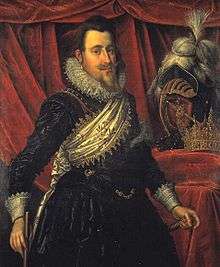Pieter Isaacsz

Pieter Isaacsz (1569, Helsingør – September 14, 1625, Amsterdam), was a Danish-born Dutch Golden Age painter.
Biography

According to van Mander his father was from Haarlem and he learned to paint in Amsterdam for a year and a half by Cornelis Ketel, and later by Hans von Achen.[1] Van Mander claimed he still lived in Amsterdam and went on to describe several portraits by him which he particularly admired, including a half-length portrait of Sara Schurmans playing a citar. His most popular piece was an oil-on-copper painting with a procession of angry women in Rome on hearing that the Senate had decided in favor of polygamy for men.[1] According to Houbraken (who mistakenly called him Pieter Fransz) he later became the teacher of Adriaen van Nieulandt the younger.[2] According to the RKD he travelled back and forth to Denmark several times, which is possibly where he later died.[3] He was the subject of an exhibition at Frederiksborg Palace in 2007 as the man behind the collection's most famous portraits. According to Codart he was court painter of the Danish king Christian IV who became a spy in Swedish service and died of the plague in Elsinore.[4]
| Wikimedia Commons has media related to Pieter Isaacsz.. |
Public collections
- Rijksmuseum, Amsterdam
- Kunstmuseum Basel, Basel
- Lower Saxony State Museum, Hanover
- Frederiksborg Palace, Hillerød
- Statens Museum for Kunst, Copenhagen
- Museum of Fine Arts, Houston, Texas
References
- 1 2 (in Dutch) Hans van Aken, uytnemende Schilder van Cuelen in Karel van Mander's Schilderboeck, 1604, courtesy of the Digital library for Dutch literature
- ↑ (in Dutch) Pieter Fransz in De groote schouburgh der Nederlantsche konstschilders en schilderessen (1718) by Arnold Houbraken, courtesy of the Digital library for Dutch literature
- ↑ Pieter Isaacsz in the RKD
- ↑ Pieter Isaacsz: court painter and spy on Codart